 |
|||||||||||||
|
|||||||||||||
|
Here is an ongoing list of interstitial films available on video and DVD recommended by contributors. These are works that do not fit neatly into any one category and often break new ground altogether. Different contributors have different ideas about what makes film interstitial, which is why we have asked them to annotate and sign their recommendations. If you want to discuss these selections or recommend your own, please join us on the IA Discussion and Bulletin Board. For recommendations of live theatre performances, please consult the Bulletin board for the most current production and ticket information. |
||
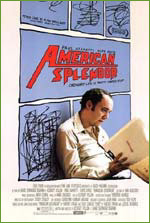 |
American Splendor. Directed by Shari Springer Berman and Robert Pulcini, (2002) This wonderful film of comic book author (and classic curmudgeon) Harvey Pekar persistently reminds you a film is being made — quirky scenes in an artificially created studio alert us to the illusionary nature of all biographical storytelling. The film imaginatively presents a man whose image has been recreated by a host of different artists, his life transformed into art that is itself multiplied by the particular view point of the artist creating the image of Harvey. One of my favorite moments in the movie is when Joyce (his future wife) worries about meeting Harvey the first time because she is not sure which of the representational drawings of Harvey is true. Additionally, the film allows the fictional characters played by actors to interact with their originals in odd parallel moments and these composite views make them seem simultaneously ordinary and larger than life. Added to all of this is the interweaving of the comics themselves, animated moments of the drawn versions of Harvey and his friends' art talking back to the man who inspired it. (Midori Snyder) |
|
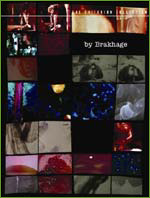 |
By Brakhage: An Anthology. The Criterion Collection, (2003) Wow...Stan Brakhage made these amazing small art films throughout the last four decades. They are visionary, dramatic, and original. Among my favorites is Mothlight, in which Brakhage applied the wings and bodies of moths (along with slices of plants) directly to the 16mm clear celluloid and then printed it. This captivating silent film is eerie, as the frail moths flicker on the screen moving toward their own deaths. The Dante Quartet is an explosion of color and emotion — the movement between hell and paradise expressed solely in the profusion of images. The Criterion DVD is of excellent quality and contains two discs with 26 of these remarkable films. (Midori Snyder) |
|
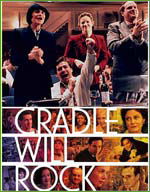 |
Cradle Will Rock. Directed by Tim Robbins, (1999) A classic example of why the world needs IA: the studio didn't know how to market it, and the critics didn't know how to review it. Based on the 1937 pro-labor union leftist musical by Marc Blitzstein (later famous for his 1950's English translation of the Brecht/Weill Threepenny Opera), this film is about Blitzstein trying to write the musical and get it produced; it incorporates numbers he's composing as fantasy, scenes from the notorious New York Federal Theater Project-funded performance, and encouraging ghostly visits from his dead wife. Indescribably entertaining and smart and uncategorizable, as a "movie musical" The Cradle Will Rock is to the blockbuster Chicago as the works of Gabriel Garcia Marquez are to those of Terry Brooks. (Ellen Kushner) |
|
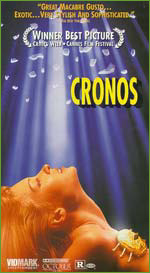 |
Cronos. Directed by Guillermo del Toro, (1993) With this, his first film, del Toro moved straight into the ranks of filmmakers such as Jean Cocteau. While del Toro affirms that he's a horror film maker (who was terrified at age 2 by an episode of "The Outer Limits"), his tale is a horror film transcending the genre not only in terms of the camerawork, but also in the shrugging off of most tropes of the traditional vampire story, serving up something we haven't seen before much less imagined, much as Cocteau held us spellbound when his Orpheus slipped through a mirror into the underworld. It's a horror film that shuffles the world into new shapes, something few films do in or out of genre (Gregory Frost) |
|
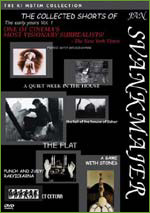 |
Collected Shorts of Jan Svankmajer: Volume I and II. Image Entertainment, (2003) Czech phenomena Jan Svankmajer is the master of many arts, all of which are used to brilliant and astonishing effect in his short films. Combining the wonderfully insane and creepy sensibilities of Edgar Allen Poe and the playful and terrifying vision of the Surrealists with puppetry, live action, animation, and sculpture, Svankmajer's films are rich and extreme explorations of human life, the material world of creation and decay, and our own troubled imaginations run wild. These two volumes provide stunning examples of Svankmajer's work: Flor,a with its single image of a human figure composed of flowers and vegetables tied to a hospital bed and allowed to rot; Food, where two men in a bizarre contest consume first their meal, then the dishes and tables, then each other; The Fall of the House of Usher, Svankmajer's interpretation of Poe's story, focusing the lens of the house itself as a decaying reflection of the doomed twins. For a truly comprehensive and informative site on Svankmajer's work have a look at Michael Brooke's web site Jan Svankmajer, Alchemist of the Surreal (Midori Snyder) |
|
 |
Dracula, Pages From The Virgin's Diary. Directed by Guy Maddin, (2003) And you thought you'd seen every Dracula imaginable...funny how this story keeps cropping up, and this version more interstitial than usual. Guy Maddin is a brilliant and eccentric Canadian filmmaker who was commissioned by the Canadian Broadcasting Corp to make a film of the ballet "Dracula" (adapted and choreographed by Mark Godden) as performed by the Royal Winnipeg Ballet. Maddin's earlier film work was heavily influenced by silent films and here it is put to terrific use. Accompanied only by the music of Gustav Mahler, this film is shot in black and white-except for punctuated moments of brilliant red. It reproduces a lush and sensual Dracula. Maddin shot from among the dancers, using handheld cameras-video and super 8-to place the viewer intimately amidst the dance. The story of the ballet features Dracula as the doomed revolutionary, fighting not only the text of Victorian sexual repression, but also (if we add in the fact that the principal dancer playing Dracula is Chinese (Zhang Wei-Qiang)) a nod to the xenophobic fear of the Western world towards outsiders. (Midori Snyder) |
|
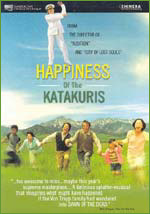 |
Happiness of the Katakuris. Directed by Takashi Miike, (2003) This film is one of the most perplexing and bizarre treats I've viewed in ages. Miike is best known for his relentlessly violent and blood-drenched gangster movies-weird living color anime film noir offerings (if you like his work, consider having a look at Tom Mes's highly informative work Agitator, The Cinema of Miike from Fab Press, 2004). I'd been told this recent film in DVD was a comedy — but I'll admit to watching it nervously, prepared to duck at the first signature shots of slashing. Instead I gaped, puzzled and bemused, at this darkly funny and totally surreal little film about a Japanese family running a guest house in a remote mountain area. The problem is that the guests (rather unsavory all of them) keep dying and the bodies start multiplying in the woods where they refuse to stay put. The film is punctuated with sudden surreal moments of claymation — and then there are the musical numbers. Big cheerful, whimsical, nonsensical musical numbers — sort of The Sound of Music meets Dawn of the Dead. (Midori Snyder) |
|
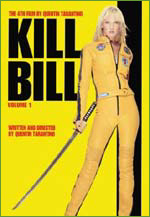 |
Kill Bill Volume I. Directed by Quentin Tarantino (2003) What a wonderful outrageous and visually electrifying film-leaping effortless among anime, Japanese gangster movies, Hong Kong cinema, 70's street movies, some of the silliest of T.V. superheroes, and four hundred gallons of fake cranberry blood (an industry record). Tarantino lavishly exploits the tropes of Eastern cinema, but with a killer eye for the mise en scene, the darkly humorous dialogue, and the striking Uma Thurman as "The Bride." This film has it all — including a spectacular sequel, Kill Bill Volume II that pays homage this time to the classic American Western film. And there's talk of a third film waiting in the wings...the further adventures of the Lioness and her cub. (Midori Snyder) |
|
 |
One Giant Leap. Directed by Duncan Bridgeman and Jamie Catto. (2002) This unusual DVD contains an interstitial mix of music, words, and imagery from around the world. Duncan Bridgeman and Jamie Catto (Faithless) traveled through twenty-five countries to gather music by a wide variety of famous and obscure musicians ranging from Michael Franti and Robbie Williams to Baaba Maal, Asha Bhosle, and the Native American women's group Ulali. They then assembled their findings into one rich, collaborative musical work, blended here with snippets of interviews with philosophers, spiritual leaders, teachers, writers, and other folks discussing life, death, work, play, time, and other topics. Part musical odyssey, part travelogue, part meditation on 21st culture and thought, this is a work of art that crosses many borders, both literal and metaphorical. The music is also available as a separate CD (Universal, 2002). It's a terrific CD...haunting, uplifting, and irresistibly dance-able too. (Terri Windling) |
|
 |
Straight to Hell. Directed by Alex Cox. (2002) This is the movie Cox made after making Sid and Nancy, and it involves a lot of people who were clearly hanging around the S&N set causing trouble. It's so fantastically interstitial that I must say that I watched it 3 times and enjoyed it immensely without really understanding that there was a coherent plot. There is one, though. You must trust me on this. It's completely unclear where this movie takes place. Mexico? Spain? America? It's clearly paying homage to spaghetti westerns...but why, then, does the adulterous wife of the hardware store owner speak with a French accent? The Pogues — The Pogues! — play a gang of coffee-addicted outlaws, while Sy Richardson, Dick Rude, and Joe Strummer play three black-suited hitmen (Quentin Tarantino wishes he made this movie) and Courtney Love plays Richardson's 8-month pregnant girlfriend. There's a suitcase full of stolen money involved, a lot of phallic power symbols that don't work at key moments, and some immortal lines. The movie is sheer anarchic chaotic lunatic brilliance and includes a gunfight between Joe Strummer and Shane McGowan. What more could a person want? (Veronica Schanoes) Back to the top |
|